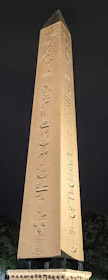COVERED WITH HIEROGLYPHS, and standing close to Istanbul’s Sultanahmet Mosque, there is a tall obelisk mounted on 4 metal brackets, which rest on a stone block covered with bas-relief carvings. It is called Dikilitas in Turkish, and The Obelisk of Theodosius in English.

Over 65 feet tall, it is only a small part of an obelisk that was commissioned by the Egyptian Pharaoh Thutmose III (1549-1503 BC), and it stood opposite Thebes. The fragment that stands in the former hippodrome of Istanbul was brought to what was then Constantinople in the 4th century AD. It was erected in its present position by Emperor Theodosius the Great in 390 AD.
The carvings on the plinth that support the obelisk depict Theodosius and his officials involved with the races that were held in the hippodrome. The obelisk and two other vertical structures marked the cental line or long axis of the race course.
During our current visit to Istanbul, we often walk past the obelisk on our way to our nearest tram station. We usually do this in daylight. However the best time to see the obelisk is after dark when it is beautifully illustrated with spotlights that enhance the appearance of both the hieroglyphs and the sculptures below it.
Published on April 28, 2024 22:33
